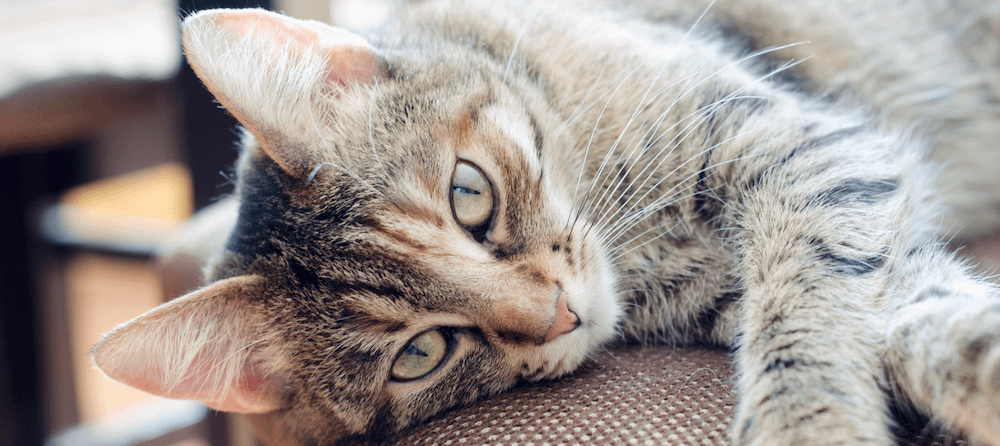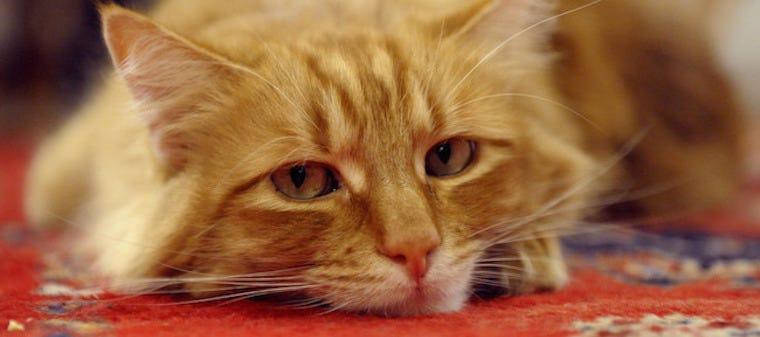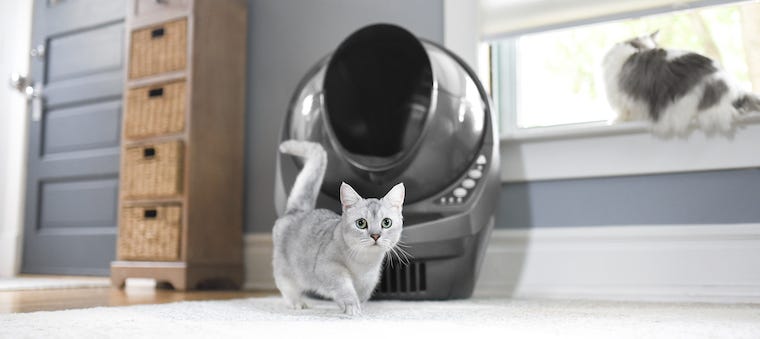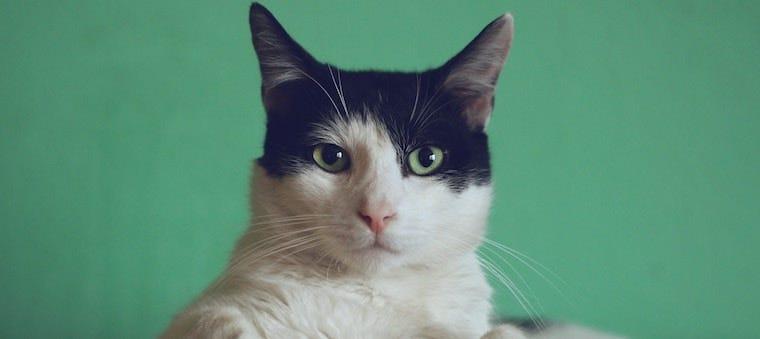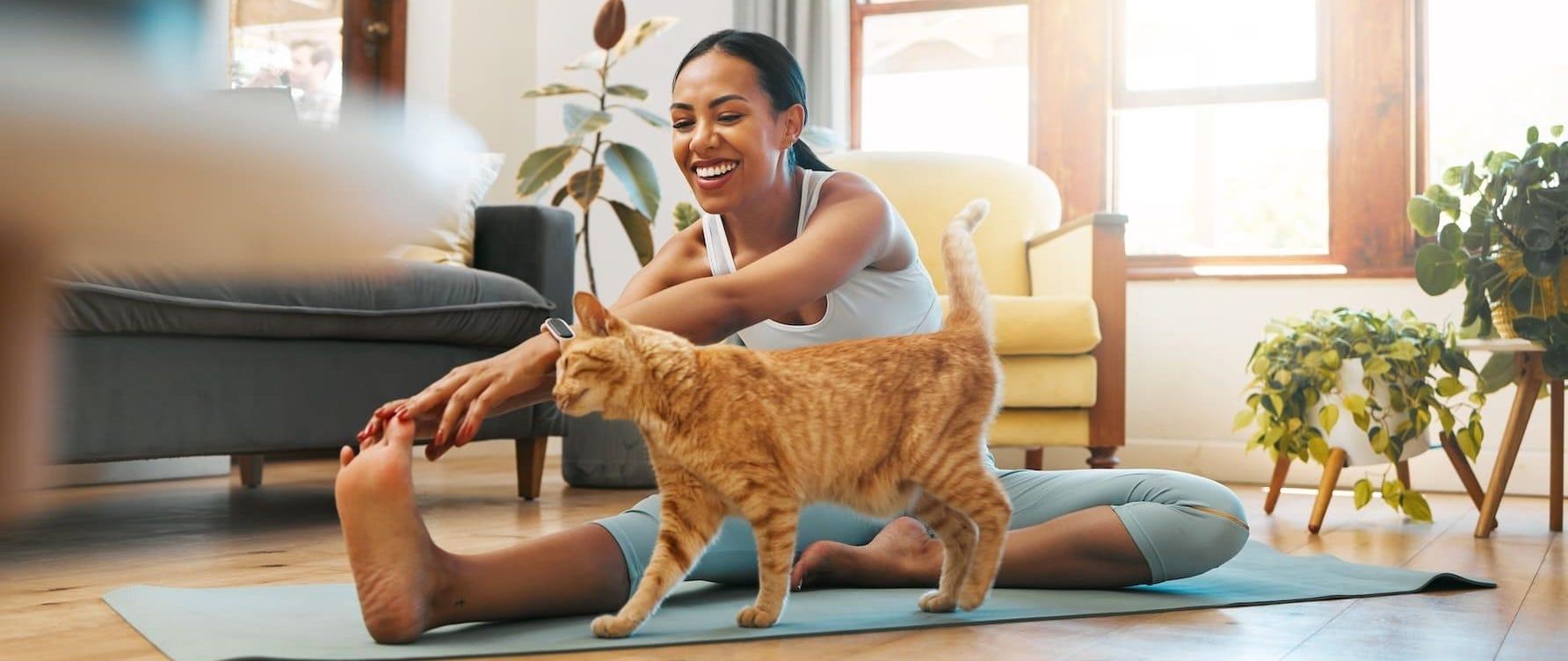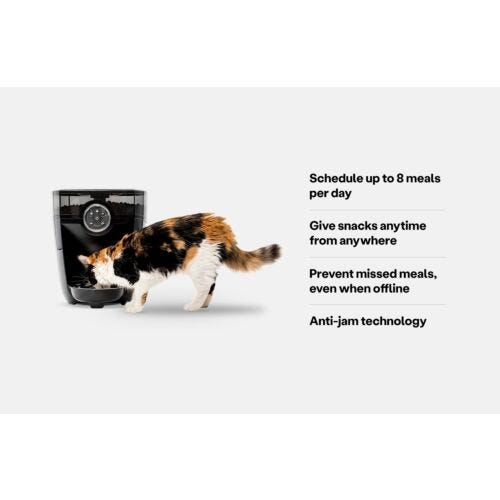If you’ve never had a cat, you might wonder how often they go to the bathroom. However, the question that cat parents should be asking is, how often should cats poop? As with people, those two answers are different for every individual and sometimes vary enough to warrant medical attention.
How often your cat goes to the bathroom, what their poop looks like, and even what it smells like can indicate what’s normal and what’s not. Learn more about what’s normal when it comes to cat poop and when you may want to reach out to a veterinarian.
How often should cats poop?
There’s no one-frequency-fits-all solution to this question, but a general rule of thumb is that pooping once or twice daily is considered normal for cats. What your cat consumes in a day and how much activity they get might alter just how fast they digest on any given day.
Kittens tend to poop more often than adult cats, so as your cat ages, they will begin to poop less and less. Other factors that impact your cat’s frequency include diet, activity level, medications or supplements, and underlying medical conditions.
If you suspect something might be wrong because your cat’s bowel movements have changed, consider contacting your veterinarian to set up an appointment to check for any health issues.
Factors that can affect a cat’s bathroom habits
All cats have different bowel movements, and you’ll likely figure out what normal looks like for your cat. When something is abnormal, you may be quick to point it out.
Below we will discuss six factors to consider when wondering about your cat’s bowel movements:
Age
Kittens are not born with the knowledge of how to control their bowel movements, similar to human babies. Until a certain age, your kitten is likely to go more frequently throughout the day until they learn how to control and get into a habit of going. Additionally, when kittens transition from their mother’s milk to cat food, this can also affect what your cat’s stool looks like, as well as the frequency.
Water intake
A cat that is not drinking enough water may have more irregular bowel movements. Water helps lubricate the gut and move stool along so it can pass easily. Monitor your cat to ensure they are getting enough water, especially if you notice irregular bowel movements.
While kittens drink their mother’s milk, older cats need water. If your cat seems hesitant to drink the still water in their dish, consider a running water fountain for them. Their food type can also affect hydration levels. Wet food is more hydrating. If your cat eats dry kibble, consider sprinkling it with water or some cat-friendly broth.
Diet
Cats that have recently changed their diets may need time to adjust. It is always recommended that diet changes be gradual over several days if feasible. When this is not possible, and sometimes even when it is, diarrhea and constipation can occur. Sometimes the diet that your cat is enjoying won’t have enough fiber, which may make passing bowel movements more difficult. Making light adjustments to your cat’s diet can greatly impact the frequency in which they go.
General health and health problems
A sick cat may experience gastrointestinal distress until they’ve been treated. Intestinal parasites, hyperthyroidism, irritable bowel disease, and chronic kidney disease are a few of the conditions that could be to blame.
Additionally, some medications your cat may be prescribed can irritate their digestive system, causing an upset stomach.
Activity level
More active cats often have quicker metabolisms and can digest foods faster. This usually makes going to the bathroom easier, meaning your cat may go multiple times a day.
Environmental factors
Depending on what is going on in your home life, your cat may be experiencing more stress than usual. This can cause diarrhea or constipation and can be resolved if you fix whatever is stressing your cat. Sometimes moving or bringing a new pet into the home is also one of the common causes of gastric distress.
What does normal cat poop look like?
It may not be glamorous, but checking in to see what you’re scooping out of the litter box (or what your self-cleaning litter box is scooping for you) is often smart. How can one identify abnormal poop effectively if they are unsure what normal is?
It’s usually very noticeable when something is wrong with your cat’s poop. Healthy cat poop, as seen in the image below, will appear sausage-shaped, dark brown, and firm yet pliable.

Normal and abnormal cat poop chart
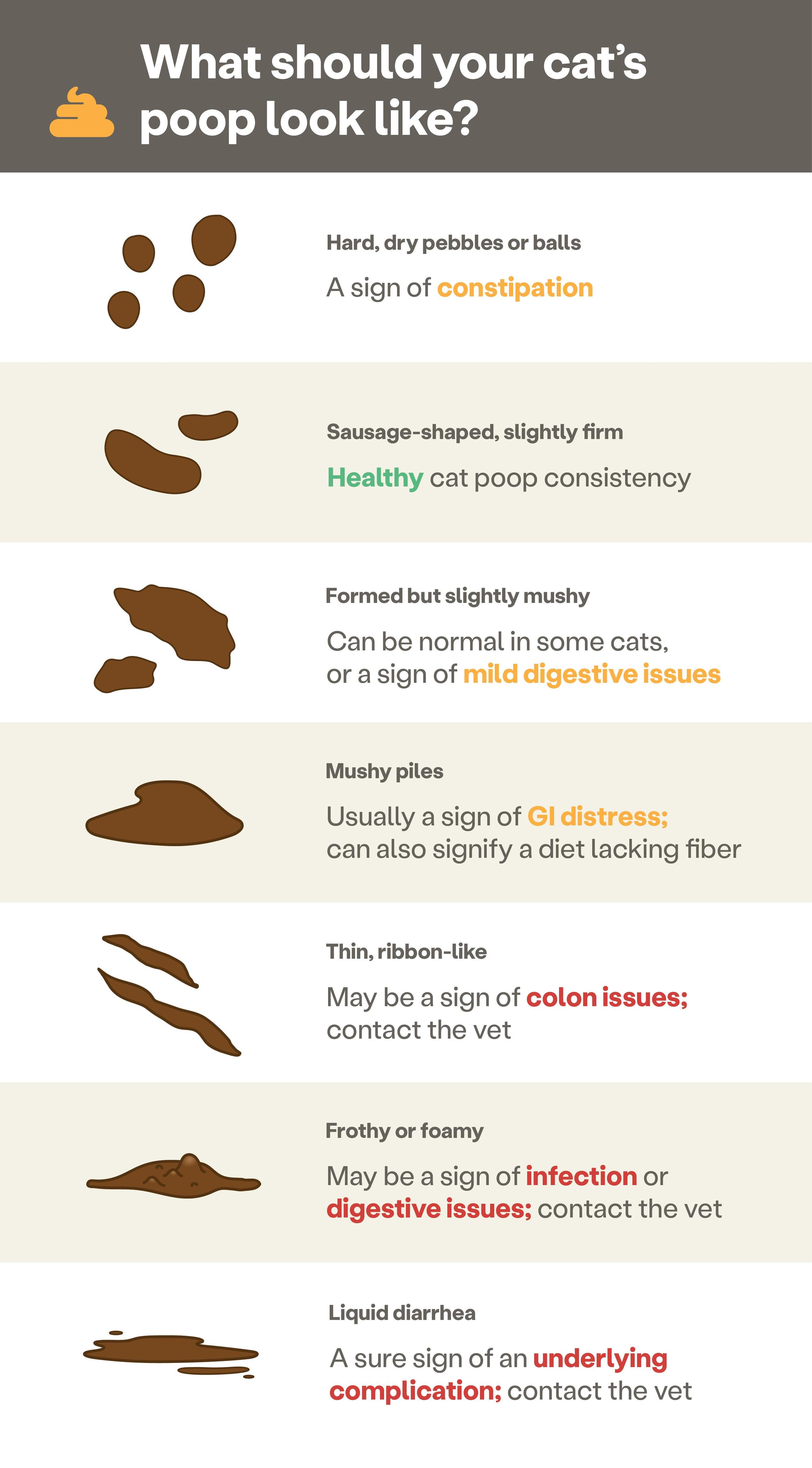
What's normal in terms of cat poop consistency?
- Hard, dry pebbles or balls are a sign of constipation.
- Sausage-shaped, slightly firm is healthy cat poop consistency.
- Formed but slightly mushy can be normal in some cats, or a sign of mild digestive issues.
- Mushy piles are usually a sign of GI distress; they can also signify a diet lacking fiber.
- Thin, ribbon-like poop may be a sign of colon issues; contact the vet.
- Frothy or foamy poop may be a sign of infection or digestive issues; contact the vet.
- Liquid diarrhea is a sure sign of an underlying complication; contact the vet.
Cat poop color chart
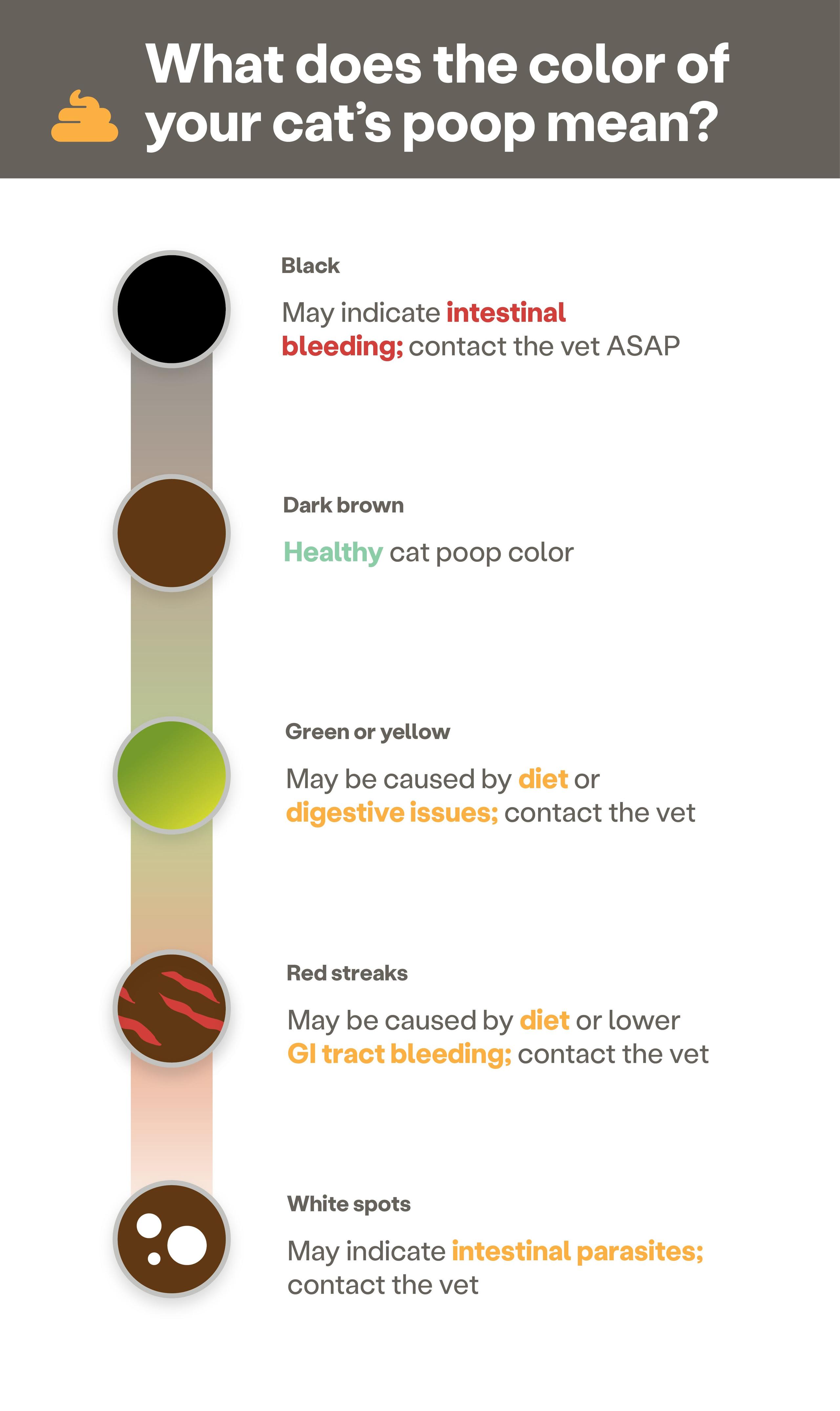
What does your cat's poop color mean?
- Dark brown is a healthy cat poop color.
- Green or yellow poop may be caused by diet or digestive issues; contact the vet.
- Black poop may indicate intestinal bleeding; contact the vet ASAP.
- Red streaks may be caused by diet or lower GI tract bleeding; contact the vet.
- White spots may indicate intestinal parasites; contact the vet.
If your cat’s abnormal poop is paired with other symptoms, contact their vet to set up an appointment as soon as possible. They may even ask you to collect a stool sample to bring with you when you go. On top of having irregular stools, collecting a poop sample in-hospital requires rectal palpation, which can add additional stress to an already stressful situation.
Irregularities to look out for
If you notice your cat making frequent trips to the litter box, first verify whether your cat is actually “going.” For instance, if your cat is straining to defecate, this could indicate a number of medical issues that warrant a veterinary visit, such as constipation or inflammatory bowel disease (IBD). And if your cat is just plain going a lot, it could be a sign of stress and anxiety.
Looking for an easy way to keep tabs on your cat’s litter box habits? Litter-Robot 4, a WiFi-enabled, self-cleaning litter box, has a smartphone app that allows you to monitor how often your cat uses the litter box. A spike in litter box activity—whether your cat is urinating more, defecating more, or straining to do anything at all—indicates that a trip to the vet is a must.
Going every few days
According to veterinarian Dr. Justine Lee, cat constipation can be an uncomfortable, chronic problem in felines. Constipation is more common in middle-aged (8 or older) and senior cats. Left untreated, constipation in cats can lead to an enlargement of the colon—which is difficult and costly to treat.
How long can a cat go without pooping?
If you notice that your cat only poops every two to four days, strains to poop, or takes an unusually long time in the litter box, make an appointment with a veterinarian.
Constipation can be especially dangerous for very young kittens. If your kitten hasn’t pooped in three days, get to a veterinarian to check for blockages and other issues.
Home remedies for cat constipation
There are many ways to treat cat constipation at home. Simple dietary changes include transitioning to high-fiber kibble (this typically requires a prescription from your veterinarian), trying a pet water fountain to increase your cat’s hydration, or adding 1/2 teaspoon to 1 teaspoon of canned pumpkin to your cat’s diet daily.
Safe laxatives like oral psyllium products (such as Metamucil, 1-4 teaspoons per meal) can be mixed into canned food, although not all cats will eat this mixed in their food. Another option is the laxative MiraLAX® (polyethylene glycol); this can be given at ¼ teaspoon every 12 hours as a starting point, but can be increased based on guidance from your veterinarian. It is best to check in with your veterinarian prior to giving your cat any over-the-counter medication to ensure appropriate dosing and frequency before deeming a treatment option unsuccessful.
Never give an over-the-counter enema to your cat without consulting your veterinarian.
Overly frequent bowel movements
While going regularly is ideal, some cats may seem to poop more frequently than they should. There might be an underlying medical condition that needs attention from a vet or stress that needs to be treated.
Other factors include:
- Change in diet
- Allergies to food or food intolerance
- Parasites
- Bacterial infections or imbalances
- Anxiety
- Toxins
- Inflammatory bowel disease (IBD)
What if my cat has diarrhea?
Cat diarrhea isn’t uncommon, but it’s also not something to ignore. Diarrhea in kittens and senior cats is especially a concern, as they are quicker to succumb to dehydration. Diarrhea that lasts longer than 48 hours in any cat warrants a vet visit.
Some causes of diarrhea in cats include:
- Food intolerances or allergies (cats generally don’t tolerate dairy, for instance)
- Toxic substances consumed (plants, herbs, garlic, onion, etc.)
- Inflammatory bowel disease
- Gastrointestinal worms
- Pancreatitis
- FIP
- Colitis
- Lymphoma
Blood in stool
Don’t panic if you notice a little blood in cat poop. While it’s not normal, it could simply be an instance of your cat straining too hard to poop. However, if you notice a lot of blood, or if blood makes a regular appearance in the litter box, make an appointment with your cat’s veterinarian immediately. Blood in cat poop can be caused by the same underlying issues that cause diarrhea, such as IBD, worms, food allergies, cancer, or even life-threatening bowel obstruction.
Something protruding from their behind
Contact your veterinarian immediately if you see something coming out of your cat’s behind that is not identifiable or clearly feces. While it may seem appropriate to assess the situation thoroughly before deciding to pull it out, this can be very dangerous without knowing what it is or what it is attached to. Sometimes pulling can do more harm than waiting for an exam at the veterinarian. It could be string, a stick or piece of grass, dental floss, or even hair.
In general, you don’t want to pull out this string yourself. It could be wrapped around the cat’s intestines or other internal organs, so contact your vet immediately for advice on how to proceed.
Abnormal stinkiness
Finally, one last factor when it comes to cat poop: How stinky is too stinky? Of course, there will be some degree of odor when dealing with feces, but anything downright foul or any change in odor (including the level of stinkiness) should be brought to your vet’s attention. Extremely smelly cat poop could be a sign that your cat’s diet needs to change or that your cat has some illness or infection.
If you’re dealing with a “normal” degree of litter box odors but still can’t stand the smell, consider a litter box that’s made with odor control in mind—like Litter-Robot.

As unpleasant as it can be, pay attention to your cat’s litter box habits—including what their poop looks like and how often they go. Check out our full litter box guide for any help and when in doubt, ask your veterinarian what should be considered normal in your cat’s case. Every kitty is different, after all!
When to take your cat to the vet
When you notice a change in your cat’s pooping behaviors, it’s probably safe to call your vet and ask what they think. They will know best about what you should do and might advise you on how to help your cat before bringing them in. Chatting with your veterinarian and getting their opinion will give you some peace of mind.
Changes in bowel movements don’t always warrant an emergency, but it’s best to be safe!
Sources:
- Diarrhea in Kittens | NCBI
- The Ins And Outs Of The Litter Box: A Detailed Ethogram Of Cat Elimination Behavior In Two Contrasting Environments | ScienceDirect
- Cat Poop Chart - Is Your Cat's Poop Normal? Runny or Hard? | Emergency Vet USA

